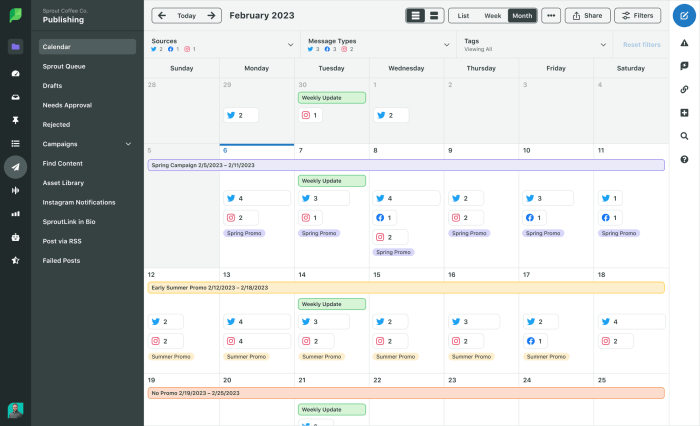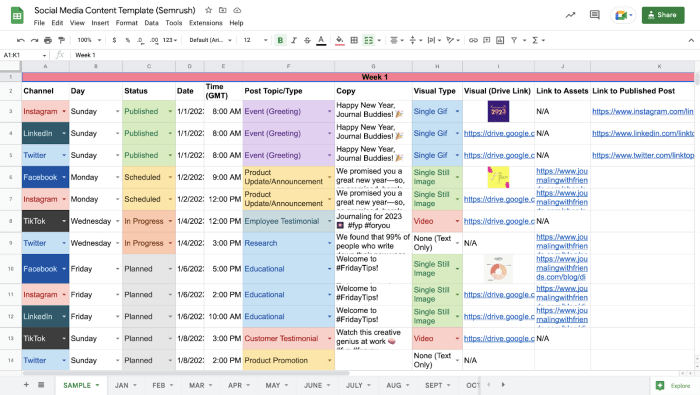Developing a Social Media Calendar is like creating the ultimate game plan for your online presence. It’s all about staying organized, maximizing efficiency, and boosting engagement. Let’s dive into the world of social media calendars and unleash their power!
In this guide, we’ll explore the ins and outs of crafting a killer social media calendar that will take your brand to the next level. From planning content to analyzing performance, get ready to revolutionize your digital strategy.
Importance of Developing a Social Media Calendar

Having a social media calendar is crucial for businesses as it helps in organizing and planning content in advance, leading to improved efficiency and effectiveness in social media marketing strategies.
Improved Organization and Efficiency
- By having a social media calendar, businesses can schedule posts in advance, ensuring a consistent presence on various platforms.
- It helps in aligning content with marketing campaigns and events, creating a cohesive and well-planned approach to social media.
- Tracking key metrics and analyzing performance becomes easier when content is planned and scheduled on a calendar.
Benefits of Planning Content in Advance
- Businesses can maintain a consistent brand voice and messaging across different social media channels.
- It allows for strategic planning of content themes, ensuring a variety of engaging posts for the target audience.
- Planning content in advance saves time and reduces the last-minute rush to create posts, resulting in higher quality content.
Components of a Social Media Calendar
Creating a social media calendar involves including essential elements to ensure a cohesive and effective strategy. Setting clear goals and objectives within the calendar is crucial for guiding your content strategy. Additionally, incorporating various types of content such as videos, images, and text can help diversify your posts and engage your audience in different ways.
Essential Elements of a Social Media Calendar
- Posting Schedule: Establishing a consistent schedule for when and how often you will post on each platform.
- Content Categories: Organizing your content into different categories to ensure a balanced mix of topics.
- Platform Specifics: Tailoring your content to fit the requirements and preferences of each social media platform.
Setting Goals and Objectives
- Increased Engagement: Setting goals to boost likes, comments, shares, and overall interaction with your audience.
- Brand Awareness: Objectives focused on increasing brand visibility and recognition among your target audience.
- Lead Generation: Goals related to generating leads and converting them into customers through social media.
Incorporating Different Types of Content
- Images: Including high-quality images that are visually appealing and relevant to your brand and message.
- Videos: Sharing engaging videos that capture attention and deliver your content in a dynamic way.
- Text: Crafting compelling captions and posts that convey your message effectively and encourage interaction.
Creating a Social Media Calendar

Creating a social media calendar from scratch involves several key steps to ensure a well-organized and effective strategy for your online presence.
Determining the Right Posting Frequency
Determining the right posting frequency for each platform is crucial to maintain engagement without overwhelming your audience. Here are some tips to help you find the balance:
- Understand your audience: Consider the preferences and behaviors of your target audience to determine how often they want to see content from you.
- Platform-specific research: Different platforms have varying best practices for posting frequency. Research the recommended posting frequency for each platform you use.
- Experiment and analyze: Start with a posting schedule and adjust based on engagement metrics. Analyze the performance of your posts to find the optimal posting frequency.
- Consistency is key: Be consistent with your posting schedule to build trust with your audience and maintain a regular presence online.
Remember, quality is more important than quantity when it comes to social media posting frequency. Focus on creating valuable content that resonates with your audience.
Tools for Designing and Managing a Social Media Calendar, Developing a Social Media Calendar
There are various tools and software available to help you design and manage your social media calendar efficiently. Here are some popular options:
| Hootsuite | A comprehensive social media management platform that allows you to schedule posts, track performance, and manage multiple accounts in one place. |
| Buffer | Another popular social media management tool that offers scheduling, analytics, and collaboration features for your social media content. |
| CoSchedule | An all-in-one marketing calendar that integrates with various platforms and allows you to plan, create, and execute your social media strategy seamlessly. |
Utilizing these tools can streamline your social media planning process and help you stay organized and consistent with your posting schedule.
Content Planning and Scheduling: Developing A Social Media Calendar
Planning and scheduling content for your social media calendar is crucial for maintaining a consistent online presence and engaging with your audience effectively.
Brainstorming and Generating Content Ideas
When brainstorming content ideas for your social media calendar, consider your target audience’s preferences, current trends, and your brand’s unique selling points. Encourage creativity within your team and leverage tools like mind mapping or content calendars to organize ideas effectively.
Maintaining a Consistent Brand Voice and Theme
To ensure a cohesive brand identity across your social media platforms, define your brand voice and theme guidelines. Use these guidelines to create content that resonates with your target audience and aligns with your brand values. Consistency in tone, style, and messaging helps build brand recognition and loyalty.
Scheduling Posts for Maximum Engagement
Timing is key when it comes to scheduling social media posts. Analyze your audience’s online behavior to determine the optimal times for posting content. Consider factors like time zones, peak activity hours, and platform-specific algorithms to maximize reach and engagement. Utilize scheduling tools to plan your content calendar in advance and maintain a consistent posting schedule.
Analyzing and Adjusting the Social Media Calendar
Monitoring and analyzing the performance of scheduled content is crucial for the success of a social media calendar. By tracking key metrics and adjusting the calendar based on insights and feedback, businesses can optimize their social media strategy for better engagement and results.
Tracking Key Metrics
Before making any adjustments to the social media calendar, it’s essential to track key metrics to evaluate its success. Some important metrics to monitor include:
- Engagement rate: Measure likes, comments, shares, and clicks on posts to determine how well your content is resonating with the audience.
- Reach: Analyze the number of people who see your posts to understand the impact and visibility of your content.
- Conversion rate: Track how many users take the desired action after seeing your social media posts, such as signing up for a newsletter or making a purchase.
- Click-through rate (CTR): Evaluate the percentage of users who click on a link in your post to visit your website or landing page.
Adjusting the Calendar
Based on the performance insights gathered from tracking key metrics, businesses can make informed adjustments to their social media calendar:
- Modify posting times: Experiment with different times of the day to see when your audience is most active and engaged.
- Optimize content: Use the data collected to create more of the type of content that performs well and resonates with your audience.
- Engage with feedback: Listen to audience comments and messages to understand their preferences and tailor your content accordingly.
- A/B testing: Test different variations of content to see what works best and apply those learnings to future posts.






